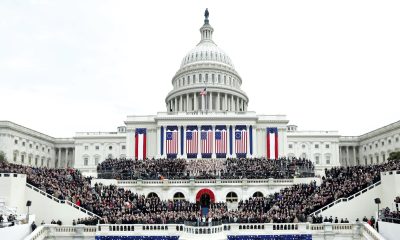Personal Finance
Education Department plans inflation fix for new FAFSA

The Department of Education said it will fix a problem with the new Free Application for Federal Student Aid (FAFSA), which would have cost students about $1.8 billion in lost federal aid, according to news first reported by NPR.
While the new form was intended to give students from low-income backgrounds access to more aid as well as streamline the application process, the tables used to determine aid were based on three-year-old data that did not account for the current high inflation environment.
The FAFSA Simplification Act passed by Congress in 2020 included a provision requiring the Education Department to update these tables annually to account for inflation and other economic changes. In an average year, inflation fluctuations are less pronounced. However, inflation rates increased by a record 18.32% from April 2020 to April 2023, according to higher education expert Mark Kantrowitz.
The Education Department had initially said that it would not update the tables, called the “Student Aid Index,” this year, but on Tuesday, it announced that it planned to fix this mistake in time for the 2024-2025 award year. The tables are used to protect a portion of family income from the financial aid formula.
“The U.S. The Department of Education will be updating the supporting tables used in the Student Aid Index (SAI) calculation that account for inflation for the 2024-2025 award year,” a spokesperson told NPR. “By doing so, students will have access to an additional $1.8 billion in federal student aid.”
If you are currently in school or starting soon, and you need more financial aid than what you can receive through FAFSA, consider taking out a private student loan while interest rates are low. Visit Credible to find your personalized rate without affecting your credit score.
HOMEOWNERS COULD SAVE TENS OF THOUSANDS IN DAMAGES BY USING SMART DEVICES
Timeline for fixes unclear
While the Education Department spokesperson said fixes would be made in the current application year, the timeline on when those fixes will be made remains to be determined and prevents families from finalizing decisions about the 2024-25 spring college semester.
“Schools were promised FAFSA applicant data by the end of January,” Justin Draeger, National Association of Student Financial Aid Administrators’ president and CEO, said in a statement. “With less than a week to go, the department has announced a significant operational change that clearly throws that date into question.
“Also concerning is the fact that institutions haven’t received any operational updates about when they will receive FAFSA applicant information, preventing financial aid practitioners from moving forward with processing and packaging financial aid offers,” Draeger continued. “Even once that information is delivered, distributing financial aid offers to students will take at least several more weeks.”
If you have filed for your FAFSA aid but need additional funding for school, consider taking out a private student loan. Visit Credible to compare multiple student loans at once and find the one with the best interest rate for you.
SOCIAL SECURITY: COLA INCREASING BUT MEDICARE COSTS RISING TOO IN 2024
More student loan forgiveness announced
Student loan forgiveness has come to millions even as the Supreme Court blocked Biden’s original debt forgiveness plan last June.
The latest block of forgiveness impacts borrowers who are teachers, nurses, firefighters and other individuals who earned forgiveness after 10 years of public service, the White House said in a statement. As much as $5 billion of student debt will be forgiven under the latest announcement, bringing the total number of people who have gotten their debt erased to over 3.7 million Americans.
Starting next month, borrowers with as few as 10 years of payments who initially took out $12,000 or less for college will have their remaining debts zeroed. Borrowers must be enrolled in the Saving on Valuable Education (SAVE) plan to qualify.
Borrowers who attend community colleges will be most impacted since these students typically borrow smaller amounts. The department estimates that the SAVE Plan will make 85% of future community college borrowers debt-free within 10 years. The SAVE Plan will also help borrowers who are more likely to struggle with their loans, as most borrowers in default originally borrowed $12,000 or less.
If you’re having trouble making payments on your private student loans, you won’t benefit from federal relief. You could consider refinancing your loans for a lower interest rate to lower your monthly payments. Visit Credible to get your personalized rate in minutes.
MORTGAGE LOAN LIMIT RISES ABOVE $1.1M AS HOME PRICES SURGE
Have a finance-related question, but don’t know who to ask? Email The Credible Money Expert at moneyexpert@credible.com and your question might be answered by Credible in our Money Expert column.
Read the full article here

-

 Investing7 days ago
Investing7 days agoMoldova breakaway region to face new power cuts on Saturday, officials say By Reuters
-

 Investing7 days ago
Investing7 days agoReebok Co-Founder Backs Syntilay’s New AI, 3D-Printed Shoe
-

 Side Hustles7 days ago
Side Hustles7 days agoHow to Survive High-Demand Seasons Without Losing Customers
-

 Side Hustles5 days ago
Side Hustles5 days ago5 Things That Could Significantly Impact Your Company in 2025
-

 Investing5 days ago
Investing5 days agoNFI Group surge after board reshaped with new appointments, chairperson By Investing.com
-

 Side Hustles7 days ago
Side Hustles7 days agoShake It Up — Dunkin’ Debuts Star-Backed Winter Menu
-

 Side Hustles6 days ago
Side Hustles6 days agoHow Failing 22 Times Paved the Way to My Success
-

 Make Money7 days ago
Make Money7 days ago9 Easy Steps to Begin Your Gold Investment Journey


















